- Joined
- Aug 23, 2016
- Messages
- 144
In Feb/March 2025 Stacy and I took an epic road trip to Baja California (report here). During that trip we took a three day tour to see rock art in the Sierra San Francisco. The works are called pinturas rupestres, which translates as cave paintings or rock paintings. The sites are referred to as caves (cuevas) even though they are not technically caves but rather overhanging canyon walls.
Radiocarbon dating indicates these works were created throughout the period from about 9000 yrs to about 500 years ago. And most amazingly, the age dating shows that some individual works were maintained over periods spanning thousands of years. Sadly, the people who created the art were gone by the time the Spanish arrived so we know almost nothing about them.
You can only visit the sites with a certified guide. There are relatively cushy (and expensive) all-inclusive guided tours or, if you are persistent and can speak Spanish (or have a Spanish-fluent friend to help), you can set up a tour on your own. We took the latter route. All of it is coordinated through the Mexican INAH (Instituto Nacional de Antropología e Historia). They oversee training of the guides and assign guides to take you to see the sites. The guides are local ranchers , which means they know the area well and can get you through some very rough country. However, they generally speak little to no English so it is advisable to learn some Spanish if you go this route. Also, if you are not at least minimally competent in the saddle (I am truly MINIMALLY competent) you could be in for a rough ride. The standard trip setup is like we did it, riding to the sites by mule with burros to carry your gear. We did a three day tour, with one day to get to our campsite on the canyon floor, one day to visit rock art sites, and one day to ride back out.
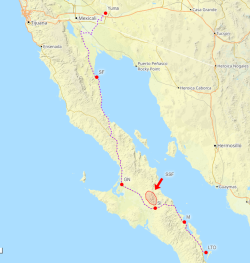
Our route through Baja with Sierra San Francisco shown. SF=San Felipe, GN=Guerrero Negro, SSF=Sierra San Francisco, SI=San Ignacio, M=Mulege, LTO=Loreto

The road leading to the Sierra San Francisco and the tiny town of San Francisco de la Sierra. Highest elevations in the Sierra San Francisco are just over 5000 ft
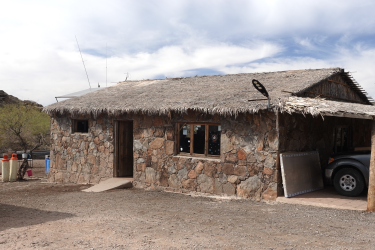
We headed up the day before our trip in order to check in and find out where to meet our guide in the morning. This is the office near San Francisco de la Sierra where a woman keeps a ledger with everyone’s reservation information. She told us our guide would be Miguel and we should meet him in the morning at his house, the blue one across from the school.
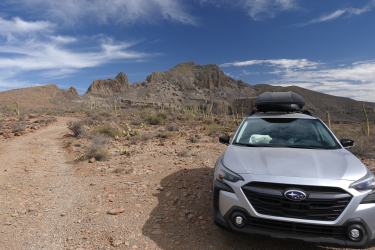
We found a level spot off the highway to spend the night.
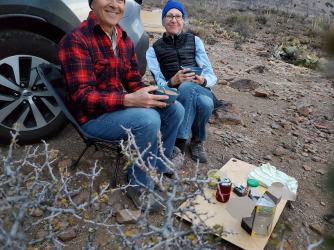
Attempt at self-portrait at camp. By morning the wind had picked up pretty good so we drove back to the office and made breakfast in the lee of the building. I am working on a windbreak setup for the back of the Subaru
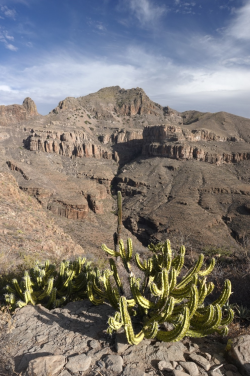
Cacti and scenery. The rock here, and in much of Baja California is relative young volcanic rock. Here we are looking at lava flows stacked one on top of the other for about 1500 ft
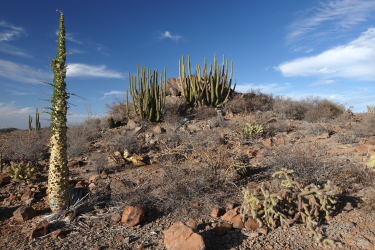
I found the plant life here to be exotic and beautiful

This is a good portion of San Francisco de la Sierra. The school playground is on the right, the green building is a small grocery store
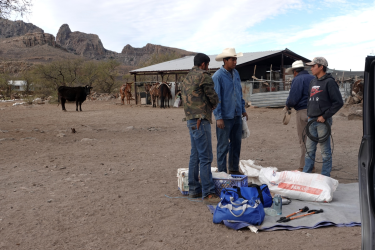
Here we are getting organized. The whole family helped load up. Our guide, Miguel, is in the camo jacket and his apprentice, Juan Enrique, is just to his left
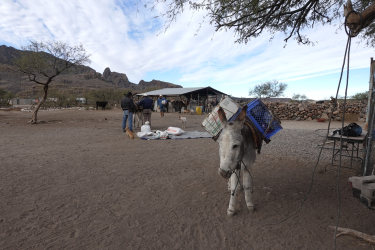
We all rode mules (very small, sure-footed mules), burros carried the gear
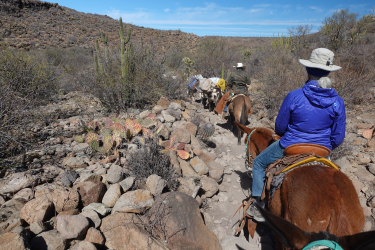
I meant to ask about this, but the burros led the way. I don’t know if they knew the trail or if Miguel sort of “pushed” them along from behind. That’s Stacy riding Estrella, I was on India.
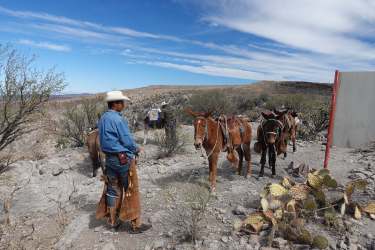
We rode along the flat mesa top for a while and eventually reached the edge of the canyon. We took a break here and Miguel and Juan Enrique adjusted our saddles for the descent
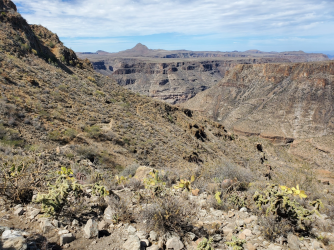
The trail is visible into the center of this photo. We are headed to the bottom of the main canyon almost 2000 ft down.
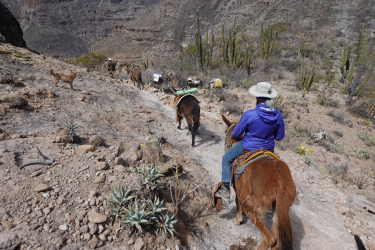
One of Miguel’s dogs, Frida, came with us. On the way back the burros headed off toward someone else’s paddock. Miguel sent Frida after them and she brought them back.
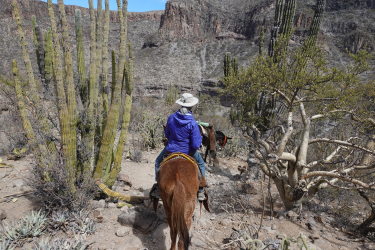
I think the cactus on the left is organ pipe, the tree on the right is a type of elephant tree, the big cactus on the right behind the tree is cardon. After this it got too steep to take pictures. I was holding on for dear life. I came up with three rules for surviving this trip. The order of the rules is very important. Rule 1: Trust your mule, Rule 2: Trust your guide, Rule 3: Trust your chosen Higher Power. Also, don’t look down.
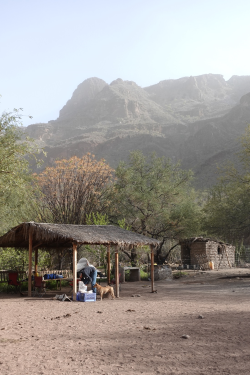
There is an established camp on the valley floor…
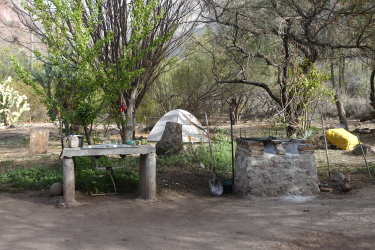
…with running water! There is a spring further up the canyon and water is piped in to the camp with enough pressure for a sink…
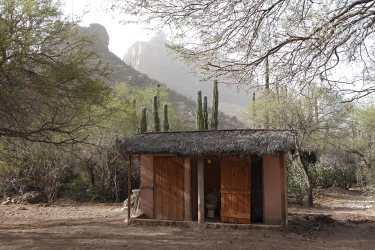
…and a flush toilet and shower! The weather was cool the whole time we were here so we didn't use the shower, which is just a pipe overhead that water runs out of, but still--wow. The wind really picked up after we reached camp. The apparent haze in the air is blowing dust.
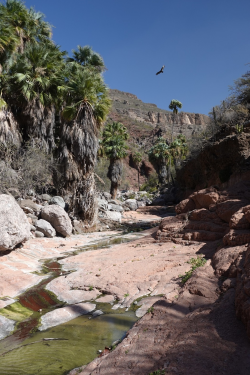
The main spring is up ahead around the bend.
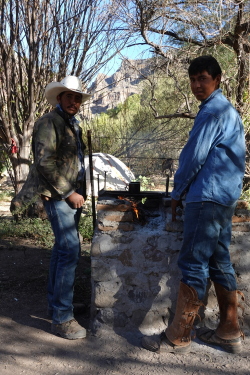
Miguel and Juan Enrique brewing up their afternoon coffee.

Classic shot of saddle gear. Two of the saddles were like the one on the left. In addition to the horn there are “wings” that go over your thighs. Stacy had one of those saddles and said it seemed to help on steep descents.
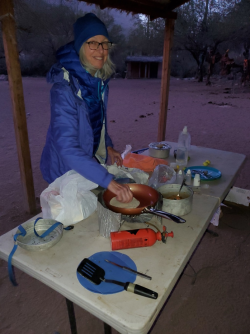
Here is Stacy cooking breakfast the first morning. The setup for these trips is interesting. You bring all the cookware and food and do all the cooking for yourself and your guide. I stressed out for months about what we were going to feed our guide. Luckily we did a kayak trip before the rock art trip and our local Mexican guides cooked for us so we got a lot of great ideas. While we were loading the burros before the trip Miguel asked if we had brought food (and utensils) for him. Later we asked if anyone had ever NOT brought food for him. He said, yes…once. There was one bit of confusion, however. We were told to bring food for ourselves and our guide (singular). But as we were about to set off we realized Miguel and Juan Enrique were both coming on the trip and we had only brought food for one. I asked Miguel and he explained that Juan Enrique was the apprentice guide and had brought his own food. In the end we combined all the food and ate together.
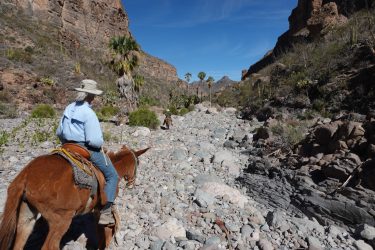
To visit the rock art sites we rode a ways down the canyon mostly right in the arroyo bottom. I found this cobblestone material very difficult to walk on but the mules handled it well.
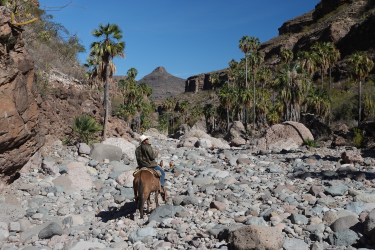
We’ll be going up the side canyon past the buttress on the right to the first site, then a little further down the main canyon to two more sites.
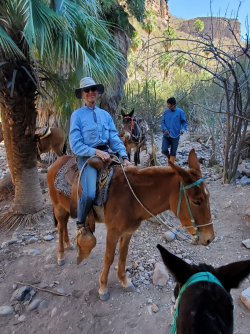
We left the mules here and walked and scrambled the rest of the way
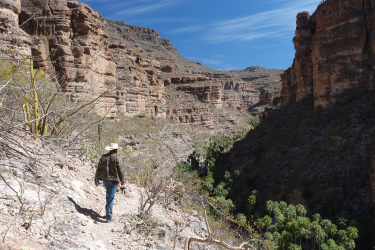
Heading up the side canyon to the first site
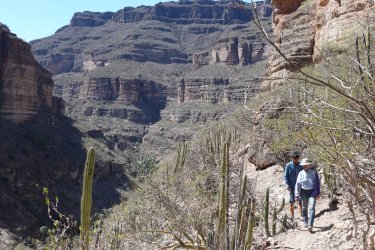
The mules are down there at the bottom of the main canyon. Our camp is up the main canyon to the left
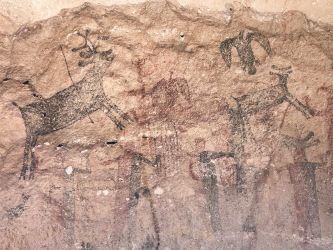
We first visited Cueva de la Soledad, or Cave of Solitude. The colors are a bit faded but it is still spectacular. It was hard to get pictures that show the scale, but these paintings are really big. The human figures at the bottom of this panel are about 6.5 ft tall. These artists drew many of their subjects from what I have seen called dual perspective—features of a profile view mixed with a head-on view. The large deer on the left, for example is shown overall in profile view but its ears and antlers are shown (each set separately) as if viewed from the front. The hoofs are similarly represented
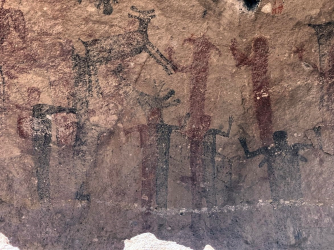
The dual perspective view is most obvious with the female figure on the right. Here a head-on view overall, but with breasts shown in profile view. At many of these sites, figures are superimposed. In the center there appears to be a human body with a deer head. Hard to tell in the photo but there are two separate drawings that overlap. The deer’s body is off to the right
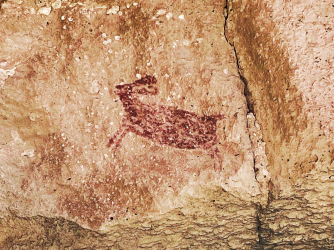
There were lots of depictions of rabbits
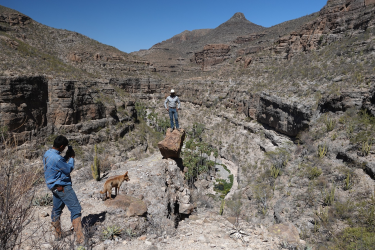
Here we are back above the main canyon. You can see the railing and platform at our next stop, Cueva Pintada, about straight to the right from Miguel’s feet. Stacy was quick to inform me that I would not be getting my picture taken on that rock.

Pintada is one of the largest and best preserved of the sites. This is probably the most spectacular portion, but it goes on for 500 ft. And the scale is mind boggling. The human figures at the bottom of this photo are almost 6 ft tall. They would have needed ladders at the very least to make these paintings and probably scaffolding. Creating this artwork was obviously very important to these people.
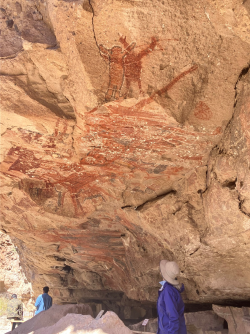
Seems they would have laid on their backs on scaffolding to paint these
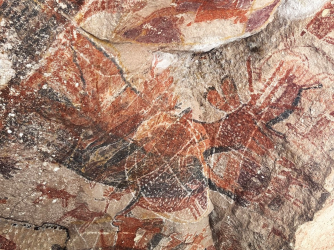
A good example here of their tendency to paint over previous works. In about the center of this one you can see three dolphins or whales. It is strange to see sea creatures in high desert rock art.
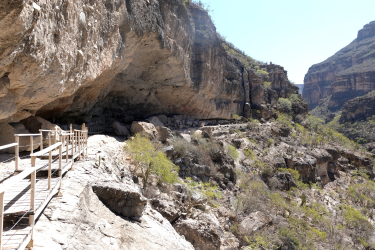
This shot helps you get the scale. In about the center of the picture you can see paintings on the rock a good 15 ft above the platform floor
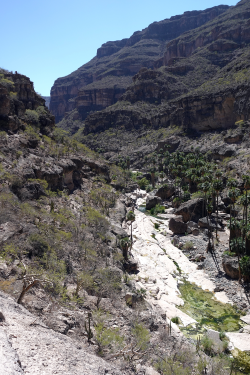
For the next site we drop back down to the main canyon and climb back up the other side. Here we are looking back up the canyon toward camp
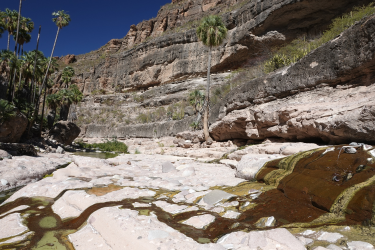
Back on the canyon floor. Cueva Pintada visible above. All of the rock art sites are near dependable water sources.
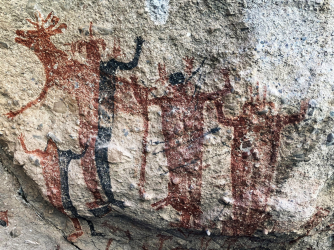
Cueva de las Flechas. Many elements similar to the other two sites but there is the one poor guy in the middle apparently pierced by half a dozen arrows. And sadly, like so much of what we see in these works, we just have to admit that the meaning is unknowable. For scale, the small figure on the left is life-size.
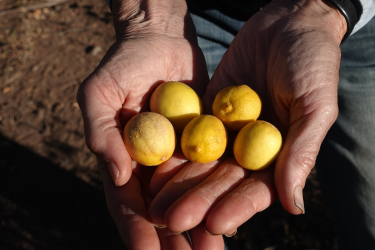
Back at camp we checked out the area a little more. At one time this place was more permanently inhabited. There is an orchard with lemons, oranges, persimmons and figs. Also grapes and various herbs.
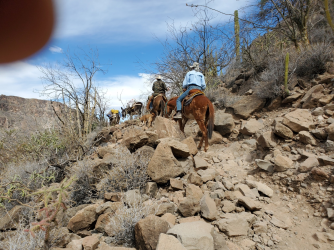
Heading out on the last day.
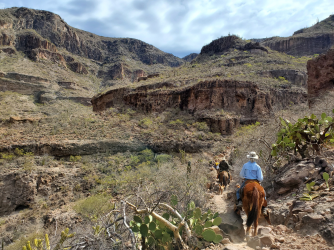
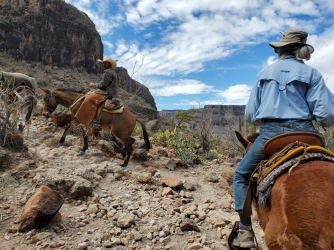
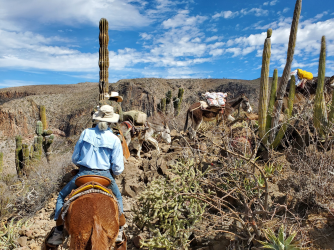 A few more trail shots
A few more trail shots
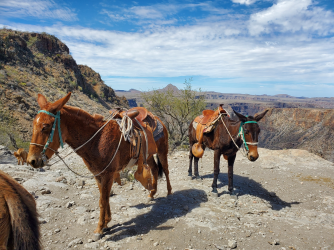
Estrella and India taking a well-earned break at the top of the climb. It was flat riding from here back to the ranch.
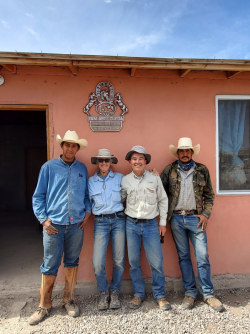
Group shot at Miguel's house.
We went into this trip not knowing what to expect. It turned out to be just amazing. Honestly, the trip would have been worth it just to see this part of the world, never mind the mind-blowing artwork. Miguel and Juan Enrique spoke very little English but Stacy and I speak just enough Spanish to get by. I imagine we probably entertained them with our espanol primitivo. For more information there is a wonderful book describing modern exploration of the rock art sites, The Cave Paintings of Baja California, by Harry W. Crosby. It includes beautiful photographs plus a lot of information about the present day ranching culture of the area.
Radiocarbon dating indicates these works were created throughout the period from about 9000 yrs to about 500 years ago. And most amazingly, the age dating shows that some individual works were maintained over periods spanning thousands of years. Sadly, the people who created the art were gone by the time the Spanish arrived so we know almost nothing about them.
You can only visit the sites with a certified guide. There are relatively cushy (and expensive) all-inclusive guided tours or, if you are persistent and can speak Spanish (or have a Spanish-fluent friend to help), you can set up a tour on your own. We took the latter route. All of it is coordinated through the Mexican INAH (Instituto Nacional de Antropología e Historia). They oversee training of the guides and assign guides to take you to see the sites. The guides are local ranchers , which means they know the area well and can get you through some very rough country. However, they generally speak little to no English so it is advisable to learn some Spanish if you go this route. Also, if you are not at least minimally competent in the saddle (I am truly MINIMALLY competent) you could be in for a rough ride. The standard trip setup is like we did it, riding to the sites by mule with burros to carry your gear. We did a three day tour, with one day to get to our campsite on the canyon floor, one day to visit rock art sites, and one day to ride back out.

Our route through Baja with Sierra San Francisco shown. SF=San Felipe, GN=Guerrero Negro, SSF=Sierra San Francisco, SI=San Ignacio, M=Mulege, LTO=Loreto

The road leading to the Sierra San Francisco and the tiny town of San Francisco de la Sierra. Highest elevations in the Sierra San Francisco are just over 5000 ft

We headed up the day before our trip in order to check in and find out where to meet our guide in the morning. This is the office near San Francisco de la Sierra where a woman keeps a ledger with everyone’s reservation information. She told us our guide would be Miguel and we should meet him in the morning at his house, the blue one across from the school.

We found a level spot off the highway to spend the night.

Attempt at self-portrait at camp. By morning the wind had picked up pretty good so we drove back to the office and made breakfast in the lee of the building. I am working on a windbreak setup for the back of the Subaru

Cacti and scenery. The rock here, and in much of Baja California is relative young volcanic rock. Here we are looking at lava flows stacked one on top of the other for about 1500 ft

I found the plant life here to be exotic and beautiful

This is a good portion of San Francisco de la Sierra. The school playground is on the right, the green building is a small grocery store

Here we are getting organized. The whole family helped load up. Our guide, Miguel, is in the camo jacket and his apprentice, Juan Enrique, is just to his left

We all rode mules (very small, sure-footed mules), burros carried the gear

I meant to ask about this, but the burros led the way. I don’t know if they knew the trail or if Miguel sort of “pushed” them along from behind. That’s Stacy riding Estrella, I was on India.

We rode along the flat mesa top for a while and eventually reached the edge of the canyon. We took a break here and Miguel and Juan Enrique adjusted our saddles for the descent

The trail is visible into the center of this photo. We are headed to the bottom of the main canyon almost 2000 ft down.

One of Miguel’s dogs, Frida, came with us. On the way back the burros headed off toward someone else’s paddock. Miguel sent Frida after them and she brought them back.

I think the cactus on the left is organ pipe, the tree on the right is a type of elephant tree, the big cactus on the right behind the tree is cardon. After this it got too steep to take pictures. I was holding on for dear life. I came up with three rules for surviving this trip. The order of the rules is very important. Rule 1: Trust your mule, Rule 2: Trust your guide, Rule 3: Trust your chosen Higher Power. Also, don’t look down.

There is an established camp on the valley floor…

…with running water! There is a spring further up the canyon and water is piped in to the camp with enough pressure for a sink…

…and a flush toilet and shower! The weather was cool the whole time we were here so we didn't use the shower, which is just a pipe overhead that water runs out of, but still--wow. The wind really picked up after we reached camp. The apparent haze in the air is blowing dust.

The main spring is up ahead around the bend.

Miguel and Juan Enrique brewing up their afternoon coffee.

Classic shot of saddle gear. Two of the saddles were like the one on the left. In addition to the horn there are “wings” that go over your thighs. Stacy had one of those saddles and said it seemed to help on steep descents.

Here is Stacy cooking breakfast the first morning. The setup for these trips is interesting. You bring all the cookware and food and do all the cooking for yourself and your guide. I stressed out for months about what we were going to feed our guide. Luckily we did a kayak trip before the rock art trip and our local Mexican guides cooked for us so we got a lot of great ideas. While we were loading the burros before the trip Miguel asked if we had brought food (and utensils) for him. Later we asked if anyone had ever NOT brought food for him. He said, yes…once. There was one bit of confusion, however. We were told to bring food for ourselves and our guide (singular). But as we were about to set off we realized Miguel and Juan Enrique were both coming on the trip and we had only brought food for one. I asked Miguel and he explained that Juan Enrique was the apprentice guide and had brought his own food. In the end we combined all the food and ate together.

To visit the rock art sites we rode a ways down the canyon mostly right in the arroyo bottom. I found this cobblestone material very difficult to walk on but the mules handled it well.

We’ll be going up the side canyon past the buttress on the right to the first site, then a little further down the main canyon to two more sites.

We left the mules here and walked and scrambled the rest of the way

Heading up the side canyon to the first site

The mules are down there at the bottom of the main canyon. Our camp is up the main canyon to the left

We first visited Cueva de la Soledad, or Cave of Solitude. The colors are a bit faded but it is still spectacular. It was hard to get pictures that show the scale, but these paintings are really big. The human figures at the bottom of this panel are about 6.5 ft tall. These artists drew many of their subjects from what I have seen called dual perspective—features of a profile view mixed with a head-on view. The large deer on the left, for example is shown overall in profile view but its ears and antlers are shown (each set separately) as if viewed from the front. The hoofs are similarly represented

The dual perspective view is most obvious with the female figure on the right. Here a head-on view overall, but with breasts shown in profile view. At many of these sites, figures are superimposed. In the center there appears to be a human body with a deer head. Hard to tell in the photo but there are two separate drawings that overlap. The deer’s body is off to the right

There were lots of depictions of rabbits

Here we are back above the main canyon. You can see the railing and platform at our next stop, Cueva Pintada, about straight to the right from Miguel’s feet. Stacy was quick to inform me that I would not be getting my picture taken on that rock.

Pintada is one of the largest and best preserved of the sites. This is probably the most spectacular portion, but it goes on for 500 ft. And the scale is mind boggling. The human figures at the bottom of this photo are almost 6 ft tall. They would have needed ladders at the very least to make these paintings and probably scaffolding. Creating this artwork was obviously very important to these people.

Seems they would have laid on their backs on scaffolding to paint these

A good example here of their tendency to paint over previous works. In about the center of this one you can see three dolphins or whales. It is strange to see sea creatures in high desert rock art.

This shot helps you get the scale. In about the center of the picture you can see paintings on the rock a good 15 ft above the platform floor

For the next site we drop back down to the main canyon and climb back up the other side. Here we are looking back up the canyon toward camp

Back on the canyon floor. Cueva Pintada visible above. All of the rock art sites are near dependable water sources.

Cueva de las Flechas. Many elements similar to the other two sites but there is the one poor guy in the middle apparently pierced by half a dozen arrows. And sadly, like so much of what we see in these works, we just have to admit that the meaning is unknowable. For scale, the small figure on the left is life-size.

Back at camp we checked out the area a little more. At one time this place was more permanently inhabited. There is an orchard with lemons, oranges, persimmons and figs. Also grapes and various herbs.

Heading out on the last day.


 A few more trail shots
A few more trail shots
Estrella and India taking a well-earned break at the top of the climb. It was flat riding from here back to the ranch.

Group shot at Miguel's house.
We went into this trip not knowing what to expect. It turned out to be just amazing. Honestly, the trip would have been worth it just to see this part of the world, never mind the mind-blowing artwork. Miguel and Juan Enrique spoke very little English but Stacy and I speak just enough Spanish to get by. I imagine we probably entertained them with our espanol primitivo. For more information there is a wonderful book describing modern exploration of the rock art sites, The Cave Paintings of Baja California, by Harry W. Crosby. It includes beautiful photographs plus a lot of information about the present day ranching culture of the area.
Last edited:
